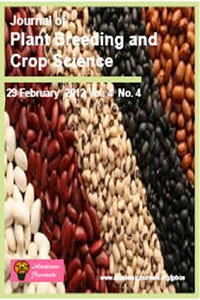Photosynthate remobilization capacity from drought-adapted common bean (Phaseolus vulgaris L.) lines can improve yield potential of interspecific populations within the secondary gene pool
Interspecific lines obtained from crosses between common bean (Phaseolus vulgaris L.) and other species from its secondary gene pool have a tendency for excessive vegetative growth and low grain yield. Contrariwise, drought-adapted common bean lines have been observed to produce high yields despite low shoot biomass production. This was attributed to greater remobilization of photosynthates to grain development. The objective of the present study was to investigate whether F2-families derived from crosses between an interspecific line and drought-adapted P. vulgaris lines have improved ability to remobilize greater proportion of photosynthate from shoot biomass to grain yield and subsequently obtain higher yield potential. Seven F2-progenies derived from crosses of an interspecific hybrid line of P. vulgaris × Phaseolus dumosus with seven drought-adapted lines reflecting a range of photosynthate remobilization and partitioning were evaluated under irrigated and rainfed field conditions along with their eight parent lines and one drought-tolerant check at the International Center of Tropical Agriculture (CIAT) at Palmira, Colombia. Although no single parent trait led to higher yield potential in progenies, the mean yield potential of the progenies, as well as mean yield under drought was significantly higher than yields of the interspecific parent, indicating that crosses with drought-adapted bean lines with greater plant efficiency constitute a promising breeding approach for yield improvement of interspecific crosses in both drought stressed and favorable environments.

